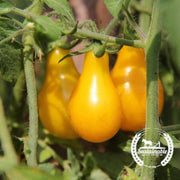Out Of Stock!
We will notify you when this product becomes available.
Tomato Seeds - Cherry - Yellow Pear (Organic)
78 Days to maturity (from transplant). Solanum lycoperscium. Yellow Pear Tomato Seeds. Non-GMO, annual, open-pollinated, heirloom, heat tolerant, indeterminate, cherry tomato. Suitable for growing in garden plots, raised beds, and greenhouses. Resistant to disorders. Unusually shaped cherry tomatoes adorn a lovely yellow color that adds brightness to dishes! This indeterminate garden vegetable bears clusters of juicy little tomatoes. ~10,500 seeds/oz.





Download Free Vegetable Growing Guide PDF
Growing Organic Yellow Pear Tomatoes in the Vegetable Garden
To grow organic Yellow Pear tomatoes successfully, start with a well-planned planting process. Begin by sowing the seeds indoors about 6-8 weeks before the last spring frost. Plant 2-3 Yellow Pear tomato seeds approximately 1/4 inch deep per cell in high-quality, organic seed-starting mix. Ensure that the soil is fertile, humus-rich, and well-draining, with a pH level of 6.0-6.8. Yellow Pear tomato seeds typically germinate within 5-14 days when provided with a warm environment, around 65-85°F (18-29°C). Once the seedlings are approximately 6-8 inches tall and all risk of frost has passed, they are ready for transplanting. During the transplanting process, space the healthy starts about 18-36 inches apart in your organic garden, allowing ample room for each plant to grow and spread. As Yellow Pear tomatoes are indeterminate, meaning they continue to grow and produce fruit throughout the season, providing sturdy trellises or supports is recommended to manage their vigorous growth and ensure healthy development in your organic garden. This planting method will set the stage for a bountiful harvest of sweet, teardrop-shaped, organic tomatoes.
Maintaining healthy organic Yellow Pear tomato plants throughout the growing process is essential for a productive harvest. To support these indeterminate vines, provide sturdy trellises or supports to prevent sprawling and promote good air circulation. For organic cultivation, consider companion planting with basil, marigolds, and nasturtiums, as they can help deter common pests and improve overall plant health. Applying organic mulch around the base of the plants can help retain moisture, suppress weeds, and maintain consistent soil temperature. Yellow Pear tomatoes thrive in well-drained, loose, slightly acidic soil with a pH of 6.0-6.8. It's essential to avoid over-fertilization with nitrogen-rich amendments, as this can lead to excessive foliage growth at the expense of fruit production. Instead, focus on organic fertilizers rich in phosphorus and potassium to promote healthy fruit development. To foster healthy organic Yellow Pear tomato plants, provide full sun exposure and ensure that they receive adequate warmth, as they are heat-tolerant. Pruning can also be beneficial to maintain good airflow, reduce the risk of diseases, and improve fruit ripening.
Harvesting Organic Yellow Pear Tomatoes
Harvesting Yellow Pear tomatoes is a rewarding part of the gardening journey. These delightful teardrop-shaped tomatoes are indeterminate, meaning they continue to produce fruit throughout the season, extending the harvesting period. Knowing when to harvest Yellow Pear tomatoes is relatively straightforward. Wait until the fruits are fully ripe, and their vibrant yellow color is a good indicator. They should feel slightly soft to the touch but still firm, and their sweet aroma will intensify. To harvest, gently grasp the ripe fruit and twist it away from the stem. The fruits typically come off the vine with minimal effort, and it's important to avoid pulling or tugging to prevent damage to the plant. You can also use scissors or shears to snip the fruit from the vine. It's best to pick the tomatoes when they are fully mature, as they won't ripen further after harvesting. Indeterminate varieties like Yellow Pear will continue to produce tomatoes throughout the season, so regular harvesting encourages more fruit production and helps maintain healthy plants.
About Organic Yellow Pear Tomato Garden Seeds
Yellow Pear tomatoes have a rich history dating back to the 18th century when they were first developed and marketed in Europe. Despite their native origins in the Americas, these golden-yellow, teardrop-shaped cherry tomatoes became a popular heirloom variety in Europe. Their unique shape and delightful, sweet flavor made them a favorite in gardens for generations.
Yellow Pear tomatoes were not specifically bred for a particular trait or growing climate; rather, their appeal lies in their unique appearance and sweet, juicy taste. Their versatile nature makes them suitable for various growing conditions, and they are known for their resilience and heat tolerance. Gardeners have enjoyed growing Yellow Pear tomatoes in a range of climates, from hot summers to milder conditions.
These tomatoes have gained a reputation for being a favorite snack in the garden. With their candy-like sweetness, many gardeners find that few Yellow Pear tomatoes make it to the kitchen, as they are often enjoyed right off the vine. They are also excellent for adding a burst of color and flavor to salads, making them an attractive and tasty addition to any culinary creation. Their indeterminate growth habit allows for continuous harvesting and a bountiful supply of these miniature pear-shaped gems throughout the summer.
Yellow Pear tomatoes can thrive in container gardens, especially if you provide them with adequate support, like a trellis. Their indeterminate growth means they can become quite tall, so managing their size and ensuring they receive sufficient sunlight is key. While hanging baskets might not be the best choice due to their potential height, you can certainly cultivate these vibrant, tasty tomatoes in pots or containers on your patio or balcony.
Tips From Our Gardeners
"When growing organically, it's crucial to maintain a regular watering schedule to ensure consistent moisture levels, but be cautious not to overwater, which can lead to diseases. Inspect your plants regularly for signs of common tomato pests like aphids, whiteflies, and hornworms, and consider introducing beneficial insects or organic neem-based treatments to address infestations."
 |
- Chelsea Hafer, True Leaf Market Writer |
Other Resources
Organic Yellow Pear Tomato Seeds Per Package:
- 250 mg packet - Approximately 105 Seeds
- 1 oz - Wholesale - Approximately 10,500 Seeds
- 4 oz - Wholesale - Approximately 42,000 Seeds
- 1 lb - Bulk Seeds - Approximately 168,000 Seeds
- 5 lb - Bulk Seeds - Approximately 840,000 Seeds
Non-GMO Organic Yellow Pear Tomato seeds are available for Fast Free Shipping on qualifying orders.
Basic Info
| Latin Name: | Solanum lycoperscium (previously Lycopersicon esculentum) |
| Tomato Type: | Cherry - Small fruited tomatoes that are often round or pear shaped. Typically the size of marbles but still smaller than a golf ball. |
| Yellow Pear Tomato Color: | Yellow |
| Yellow Pear Tomato Flavor: | Extra sweet, juicy, with minimal acid compared to larger tomatoes |
Growing Info
| Hardiness Zone: | 2, 3, 4, 5, 6, 7, 8, 9, 10, Annual: Not intended to overwinter |
| Days to Maturity: | 78 |
| Days to Germination: | 7-10 |
| Seeding Depth: | 0.25 inch |
| Plant Spacing: | 24 to 36 Inches |
| Row Spacing: | 36 inches |
| Plant Height: | 36 to 96 Inches |
| Growth Habit: | Indeterminate - Indeterminate tomatoes are vine-type plants that sprawl (requiring a cage or trellis to support them) and continue to grow throughout the season. Indeterminate tomato plants will continue to produce tomatoes for the rest of the season, so you can harvest continually. |
| Soil Preference: | Well-draining, loose (sandy loam), slightly acidic (6.2 to 6.8), and moisture retaining. Too much nitrogen in the soil may lead to more foliage production and less fruiting. Tomatoes like more phosphorus and potassium than other vegetables. |
| Temperature Preference: | Warmer (70-85 F) |
| Light Preference: | Full Sun |
Other
| Direct Sow: | No |
| Start Indoors: | Yes. Start Indoors 7-9 weeks before your last spring frost date. |
| Plant Width: | 24 to 36 Inches |
| Growth Speed: | Mid - Ready to harvest 70 to 80 days from transplant. Tricky to get a tomato by the 4th of July with these varieties. They are good mid-summer producers for most USDA Zones. |
| Germination Temperature: | 65-85 F |
| Pests and Diseases: | Resistant to disorders. Common pests known to harm tomato plants, in general, include the tomato hornworm, cutworm, aphids, flea beetles, tomato fruit worms, and whiteflies. Also, watch for common diseases such as blossom end rot, fusarium wilt, powdery mildew, verticillium wilt, late blight, bacterial canker/spot, and tobacco mosaic virus. Most of these can be prevented by maintaining a regular watering schedule and avoiding overwatering. Regularly check your plants for pest damage throughout the season. For treating pest and disease problems, we recommend using an organic neem-based product. |
| Garden Size: | Greenhouse, Garden Plot, Raised Bed |
| Tomato Use: | Salads, fresh eating |
| Climate Tolerance: | Heat |













